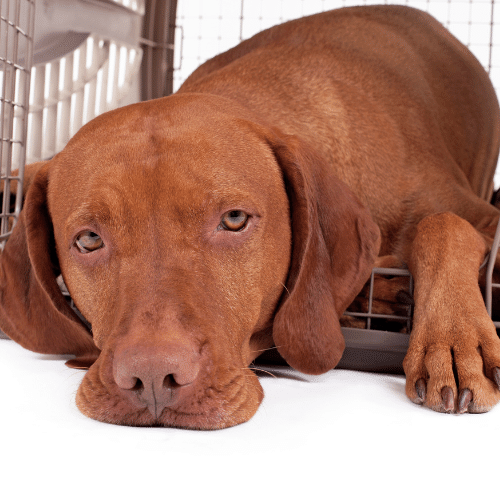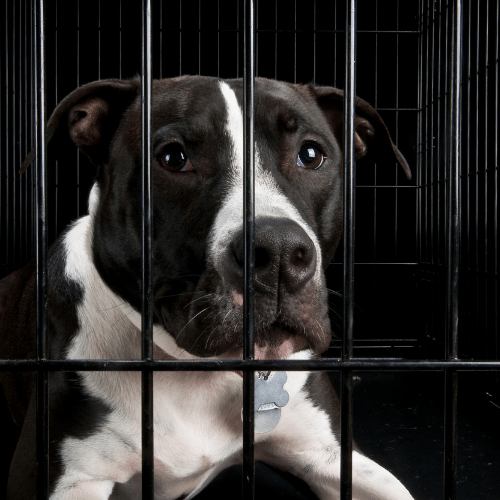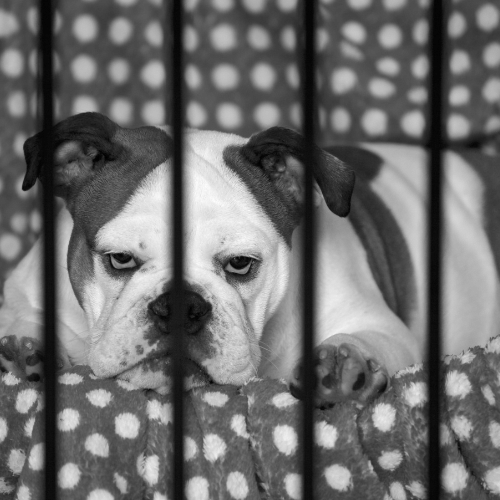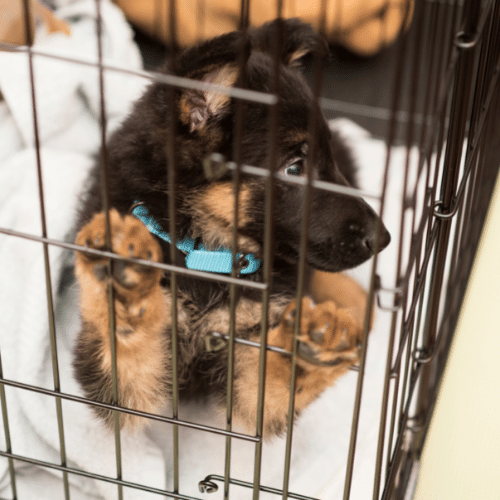When Can I Stop Crating My Dog?
August 25, 2021 2021-08-25 4:41When can you stop crating your dog?
Crate training is extremely important for dogs. Primarily, owners are usually recommended to crate train to make potty training easy. Why this is true, there are also tons of other reasons you should crate train your puppy.
If you crate train properly, the crate should become your dog’s safe space. It is where they enjoy special chews and sleep peacefully in their bed. If they become stressed, they can escape the situation by going in their crate, which should preferably be somewhere quiet and out of the way.
Therefore, there really isn’t a time when you should stoop “crating” your dog. You should always make the crate available so that your canine has somewhere to go if they need to get away for a minute.
This also provides them with a safe place to sleep. Many dogs will consider the crate their bedroom, using it to sleep and enjoy some alone time.
You can usually stop closing your dog into your crate when they are around two years of age. Before then, they are usually more likely to get into trouble. It isn’t until they mature fully that they are able to behave properly when not supervised. This is especially true for larger dogs, who tend to mature later.
Larger dogs can also do more damage with their teeth, so you should protect your home from their chewing until they are completely done teething.
When trained correctly, dogs shouldn’t mind being crated. Part of the crate training process is teaching your dog to love their crate with plenty of special chews and treats. If your dog doesn’t like their crate, you probably haven’t done enough crate training.
Table of Contents

When Should You Stop Using a Dog Crate?
You don’t really need to ever completely “stop” using it. A dog crate is far more than a tool to use during crate training. It provides your dog with a safe place to escape to. Many dogs love their crate when crate-trained properly and will use it as a bed.
If you have a lot of visitors over or your dog gets stressed for a different reason, a crate provides them with a calm place to go. A dog should feel safe in their crate, which will prevent them from feeling the need to act aggressively when they are scared. Instead, they can simply go hide in their crate.
It’s their “safe space” and shouldn’t be removed simply because they are done potty training. During car rides, it is also best if your dog is kept securely in a crate.
Of course, that doesn’t mean you have to close the crate. At some point, your dog will grow out of having accidents in the house and chewing on furniture. At this point, we recommend leaving the crate there for your dog to use as they please.
You can still give them special chews in the crate, especially if you have other dogs that may try to steal from each other. However, there is usually little need to leave them in the crate for extended periods.
Most dogs can be trusted around the house unsupervised at around two years of age. This may seem like a long time, but this is how long it takes most dogs to mature.
Even after dogs have physically matured, their brains may take a bit to mature.
Many dogs will go through a “teen” phase at around 1.5 to two years when they will act out and seemingly get far more hyperactive than you remember. Many dogs are turned over to the shelter at this point, as their owners simply think that they have a bad dog.
We don’t recommend allowing them around your home before this stage is over with.

When Can I Stop Crating My Dog at Night?
It depends on why you started crating them at night, to begin with.
If it was simply to help with potty training, then you can quit crating them when they have gone more than two months without an accident. Usually, larger dogs will reach this milestone sooner because their bladders are larger.
Small dogs may have to stay in their crate for longer since their bladders are smaller. They often are more difficult to potty train simply because you have to take them outside more often.
However, there are some reasons you may want to continue to crate your dog past the potty-training milestone.
Even if they aren’t having accidents, some dogs will get into trouble if they are not supervised. When you’re sleeping, you often can’t supervise them properly. Therefore, many puppies will need to be crated even after they are potty trained.
Many dogs cannot be trusted completely until they are closer to two years of age. We recommend crating your dog at night until they reach this milestone. If you can leave your dog alone at home without crating them for a few hours, then you may be able to leave them out of their crate at night.
You should also consider whether or not your dog will sleep in their crate if you don’t lock them in. Many dogs will automatically go to their crate at night, even if they aren’t told to go in it. Proper crate training encourages your dog to like their crate, which is very helpful at night.
If your dog doesn’t sleep in its crate without being prompted, you need to consider whether or not this is okay with you. Sometimes, your dog will whine all night to sleep on your bed – even if they never have.
Obviously, this isn’t helpful for a good night’s sleep. Therefore, you’ll likely need to continue to crate your dog at night for some time.
How Do I Start to Leave My Dog Out of the Crate?
Simply put: very slowly. You don’t want to leave them out of their crate for an extended period suddenly. Instead, you should aim to slowly let them out for longer and longer times.
You shouldn’t begin this process until they have been accident-free for at least two months. Before then, their bladder control likely hasn’t developed enough for them to go long periods without accidents. You should keep up your normal bathroom schedule.
Furthermore, you shouldn’t remove access to the crate. Dogs often see their crate as a safe place they can escape stressful situations.
For instance, many dogs will go into their crate by themselves when you leave – even if you didn’t put them in the crate before you go. If you take away access to the crate, your dog will lose access to its safe place.
You should begin by leaving your dog out of the crate for very short periods of time. You may simply want to go outside and sit in the car for ten minutes. If your puppy behaves fine while you’re gone, you can slowly increase the time.
Eventually, you’ll be able to leave your dog out of the crate indefinitely.
This doesn’t mean you can get rid of the crate, though. If you crate train your dog properly, they will continue to use it on their own free will well into their adulthood. Many will treat it as their bed and safe space.
Should I Stop Crating My Dog?
At some point, there is probably little reason to crate your dog. After they grow into adulthood and are well-behaved, you usually don’t have to crate them anymore.
When exactly this varies from dog to dog. Small dogs tend to mature faster than larger dogs. However, they also have smaller bladders, so they may need to stay crated during potty training for longer.
Usually, people stop crating their dogs whenever they can trust them to behave. Of course, when this is varies from dog to dog. It often depends on the breed, as well as the dog’s specific temperament.
When you stop crating your dog is completely up to you. Technically, you never have to stop if what you’re doing right now is working!

Crating your dog is not cruel by any means. Often, after being properly crate trained, many dogs will choose to hang out in their crate. It is their “safe space,” after all.
We never recommend removing the crate from their access – even if you decide not to force them to be in it anymore. Your dog should always be provided with a safe place that they can relax in if necessary.
Plus, providing constant access to the crate will make periods of illness and injury much less stressful for your dog. If they are already used to being in a crate, being crated when sick likely won’t cause much of an issue.
If you used several crates (for example because you didn’t want to move one from room to room), you can of course donate all but one as your dog doesn’t need to be crated regularly anymore.
Is It Cruel to Crate a Dog at Night?
It is not cruel and it does not make them aggressive, either. A crate provides your dog with a safe space for them to relax. Your dog can’t do anything wrong if they are in their crate, allowing both you and them to relax. Your dog will have a much better time if they are set up for success by being put in a crate if they can’t be supervised.
At night, you obviously can’t supervise your dog. You’re sleeping!
Your dog can potentially get into just about anything without supervision – even something harmful. You don’t want your dog to eat something they shouldn’t while you are asleep.
For their health, it is often necessary to crate a puppy at night. Watching over your dog’s health is not cruel – it’s responsible.
With the proper crate training, most dogs love being in their crate. Many will choose to sleep in it long after you have stopped making them. They will consider it their bed and often treat it as such.
Even when they are not sleeping, your dog will likely spend time hanging out in their crate. It is recommended that you continue to give them their special bones while they are in their crate, especially if you have other dogs in your house. It is

Should You Cover a Dog Crate with a Blanket?
It depends on the dog. Many treat their crate as a safe space and may feel more comfortable if it is covered. After all, they won’t be able to see what is going on, and their crate will be darker.
Usually, we recommend keeping a blanket over the top of the crate – but not covering the door. This allows your dog to go in and out as they please. You don’t want to block the doorway, or your dog may not use their crate when they want to.
If the crate’s door is closed, you can use the blanket to cover the door. This is most recommended at night when the dog will likely need it as dark as possible to sleep. It also lowers the number of stimuli coming into the crate, which can help them sleep soundly. It’s like pulling the curtains in your bedroom window.
Should I Ignore Dog Whining in a Crate?
If your dog is whining in the crate, it is usually a sign that some meets have not been met. Your dog might be bored, hungry, might need to go to the bathroom or maybe he needs a more gradual introduction to the crate.
Provide your puppy with special chews for their crate, as these can help distract them long enough to calm down.
Of course, you should never respond by punishing your dog.
Do Dogs Get Bored in Their Crate?
Not likely, especially if you provide them with special chews and similar items to keep them entertained. Some puzzle toys can even work in a crate and are extremely helpful if you want to keep your dog entertained. Of course, you should only crate your dog when he is likely to wind down and rest anyway: at night or during nap times.
A crate can reduce a lot of the anxiety a dog has by being alone. Dogs often don’t bark at cars and people going outside because it is fun; they do it because of anxiety or excitement.
When you keep your dog in a crate, it allows them to stay calm.
Proper crate training teaches your canine that their crate is a safe place that they should enjoy. For this reason, many dogs are not stressed nearly as much as you’d expect when put in their crate. After all, they know they are safe while inside it!
They don’t have to worry about anything else that is going on – and they aren’t doing anything different than they would be otherwise.
It is important to provide your dog with plenty of mental and physical stimulation when they aren’t crated, of course – a dog should never be crated for 12 hours or spend the majority of his time in a crate!
Where Do You Put a Dog Crate in the House at Night?
When deciding where to put a dog crate at night, there are a few things you should keep in mind:
- Away from your bedroom. You don’t want your dog hearing you, as this can prompt whining. If your puppy does whine, you hopefully won’t be able to hear it.
- Somewhere dark. Like people, dogs sleep better when it is dark. Put it away from the window or pull the curtain. Consider putting a blanket over it to reduce the amount of outside light your puppy sees.
- Out of the way. It shouldn’t be in a place that people are going to be walking past, especially after you put your puppy to bed.

Conclusion
Crate or pen training training your dog is important. It provides your dog with a safe place to go if they get stressed and helps you manage your dog’s behavior. A properly crate-trained dog will often appreciate their crate immensely.
However, you don’t have to keep closing the door on their crate for their whole life. At some point, your dog likely won’t need to be put into their crate anymore.
When your dog reaches this point will vary. Some will be perfectly fine starting at around a year or so. Some may not be able to behave without supervision until closer to two. Certain breeds will mature faster than others.
Many dogs will continue to use it as a bed and safe space long after you stop actively using it.
A crate or pen is also important in case your dog becomes injured or ill. Crating is often recommended in these cases – akin to bedrest.

Author: Kristin
Kristin was born in Tennessee and currently lives there with her husband and children. She is passionate about educating pet parents and helping them make the best possible decisions for their pets. She currently owns one dog, two cats, a lizard, and a variety of fish.

